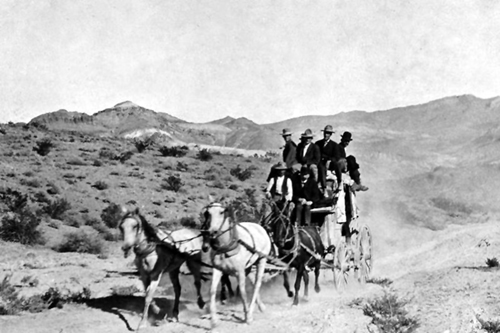
In 1849 it took 166 days to travel coast to coast. By the 1860’s you could do it in 60 days. A decade later a train could make the trip in 11 days. By 1923 an airplane could do it in 26 hours and by 1975 that was cut to 5 hours. Today, the Space Shuttle does it in 8 minutes.
Following the discovery of gold in California in 1848 Americans were pouring into the Mother Lode country and the there was an immediate clamor for mail service. The favored route was to run from St. Louis through South Pass to San Francisco but when the contract came out from the postmaster general it called for the route to go from San Diego, through El Paso, to San Antonio. This angered the folks in northern California caused a local newspaperman to declare the line went “from no place through nothing to nowhere.”
The stage line was operated by James Birch, who’d made a fortune running stagecoaches during the gold rush in California. Birch had some powerful friends in Washington so it was no surprise that when the contract was awarded he emerged the winner. He picked up a $600,000 government subsidy to haul the mail, and passengers the nearly 1,500 miles from San Diego to San Antonio.
The run began at each end of the line at 6 am on the ninth and twenty-fourth of the month. The fare one way was $200 and included all meals and a baggage allowance of 30 pounds.
The first west bound stage was driven by the celebrated old Texas Ranger, “Big Foot” Wallace. He arrived in San Diego 38 days later, 8 days behind schedule. On the return trip eastbound he traveled with Silas St. John, who would be badly injured on September 8th, 1858 at the Dragoon Springs Butterfield Station when Mexican laborers helping build the station attacked four Americans with axes and a sledge hammer, killing three and seriously wounding St. John before he fought them off with his pistol.
The passengers complained loudly of the difficulties encountered. There were 87 way stations, but only three, San Antonio, El Paso, and San Diego had any amenities.Stagecoach travel wasn’t for sissies.The rest were little more than brush and mud hovels. Floors were dirt and as one writer said, to be much like the ground outside except not as clean.
The stage traveled only during the daytime hours so the passengers were required to sleep in these dreary places. The food was barely edible, tough beef or pork, fried in a grimy skillet, coarse bread, mesquite beans, and a mysterious concoction known as “slumgullion.” There was lethally black coffee to wash it down. Dessert was a nasty compound of dried apples that paraded under the name of apple pie. The stage station always provided plenty of mustard for passengers who complained about the flavor of the food.
It was said there were three classes of passengers and when the stage reached a steep grade the first-class passengers remained in the coach, the second class passengers had to get out and walk, while those traveling third class had to get out and push the coach up the hill.
San Antonio and San Diego Mail was quickly dubbed the “Jackass Mail” because in the most severe part of the journey, crossing the California desert just west of the Colorado River there was no stagecoach service. The passengers had to get out of the coach and climb on the hurricane deck of a mule. Birch was lost at sea in 1857 and the company failed soon after. Still, the Jackass Mail became this nation’s first transcontinental passenger and mail service.
Butterfield Overland author Gerald Ahnert adds,
“After crossing the Colorado River one mile from Fort Yuma, the trail followed the west bank of the Colorado River and crossed into Mexico to go around the sand dunes. In doing some research for Frank Norris, National Park Service, I found that all references to there being a station at the foot of Pilot Knob on the Arizona side were in error. The station was actually called ‘Algodones’ and was three miles south of the border and 600 yards west of the river. There the trail turned directly west and around the southern end of the sand dunes. The trail entered southern California at New River.”





